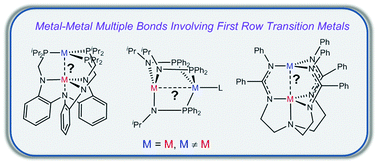Metal–metal multiple bonding in C3-symmetric bimetallic complexes of the first row transition metals
Abstract
Metal–metal multiple bonds have been an intense area of focus in inorganic chemistry for many decades as a result of their fundamentally interesting bonding properties, as well as their potential applications in multielectron transfer and small molecule activation processes. Much of what is known in this field revolves around 2nd and 3rd row transition metals, with fundamental knowledge lacking in the area of bonds between elements of the first transition series. The smaller size and tendency of first row ions to adopt high-spin electron configurations weaken metal–metal interactions and serve to complicate the interpretation of the electronic structure and bonding in bimetallic species containing first row transition metals. Furthermore, traditional tetragonal “paddlewheel” complexes dominate the metal–metal multiple bond literature, and only recently have researchers begun to take advantage of the weaker ligand field in three-fold symmetric bimetallic complexes to encourage more favourable metal–metal bonding interactions. In the past 5 years, several research groups have exploited three-fold symmetric frameworks to investigate new trends in metal–metal bonding involving the first row transition metals. This feature article serves to highlight recent achievements in this area and to use C3-symmetric systems as a model to better understand the fundamental aspects of multiple bonds featuring first row transition metals.

- This article is part of the themed collection: 2014 Emerging Investigators

 Please wait while we load your content...
Please wait while we load your content...